MOUNT ATHOS – Karoulia
This travel at Mount Athos is a combination of my two previous visits to this amazing place. This time I want to focus at Mount Athos desert – Karoulia. I will faithfully try to present the life of a hermits in this cruel part of Athos and to share their experiences and stories which you have never heard. At 08:00 we catch a boat Micro Agia Anna to Karoulia. We sail to the monastery of St. Paul and soon we can see Karoulias hermitages. With excitement, we are waiting for the moment of docking Karoulias port. We are wondering if we are really capable and brave enough to go down in the, so-called, internal Karoulia.

Monastery St. Paul

Karoulia

Hermitages at Karoulia
 We climb the stairs to the skete of Karoulia. After 10 minutes we reached the skete of Karoulia. Skete was build on the site of former cell of father Stephen, Serbian elder also known as the Pope – King. This monk spent over 40 years in this place, then he moved to a monastery Slanci in Belgrade, where he died in 2001. At the site of his burned cell, now is a skete with a church dedicated to St. Savas of Serbia. Head of the skete is Russian father Athanasius. Before elder Stephen, elder Sophronius Sakharov lived in this cell. He was a spiritual child of Elder Silouan and the author of book of this Russian saint. A lot of Russian monks lives in this part of Atos, they are majority in this unusual settlement. The Russians greeted us as brothers. They respect and love Serbs very much, because we are the only ones who still resists from the evil from the West and EU. What was fascinating about these monks is their strong faith and persistence in it, which is reflected in their attitude. Tall and strong, with bright eyes and deep voice, these ascetics are true Orthodox army. We asked about our monks at Karoulia, Simeon and Seraphim. After we drank Russian brandy, father Athanasius went to the balcony. “Pater Serafiiim !”, thundered Athanasius from the balcony. No one answers, Seraphim is at Chilandar. Father Athanasius tells us how to get down to the inner Karoulia and advised us to leave our backpacks. He is blessing us and we are going to the inner Karoulia. Following the directions of father Athanasius, we easily find the path that leads to the inner Karoulia. From the dock to this place is about 15 minutes of walk. At the beginning of the path, there is a chain and ladders. We were a little worried when we saw climbing belts hanging on a rock. They are certainly not there without a reason.
We climb the stairs to the skete of Karoulia. After 10 minutes we reached the skete of Karoulia. Skete was build on the site of former cell of father Stephen, Serbian elder also known as the Pope – King. This monk spent over 40 years in this place, then he moved to a monastery Slanci in Belgrade, where he died in 2001. At the site of his burned cell, now is a skete with a church dedicated to St. Savas of Serbia. Head of the skete is Russian father Athanasius. Before elder Stephen, elder Sophronius Sakharov lived in this cell. He was a spiritual child of Elder Silouan and the author of book of this Russian saint. A lot of Russian monks lives in this part of Atos, they are majority in this unusual settlement. The Russians greeted us as brothers. They respect and love Serbs very much, because we are the only ones who still resists from the evil from the West and EU. What was fascinating about these monks is their strong faith and persistence in it, which is reflected in their attitude. Tall and strong, with bright eyes and deep voice, these ascetics are true Orthodox army. We asked about our monks at Karoulia, Simeon and Seraphim. After we drank Russian brandy, father Athanasius went to the balcony. “Pater Serafiiim !”, thundered Athanasius from the balcony. No one answers, Seraphim is at Chilandar. Father Athanasius tells us how to get down to the inner Karoulia and advised us to leave our backpacks. He is blessing us and we are going to the inner Karoulia. Following the directions of father Athanasius, we easily find the path that leads to the inner Karoulia. From the dock to this place is about 15 minutes of walk. At the beginning of the path, there is a chain and ladders. We were a little worried when we saw climbing belts hanging on a rock. They are certainly not there without a reason. 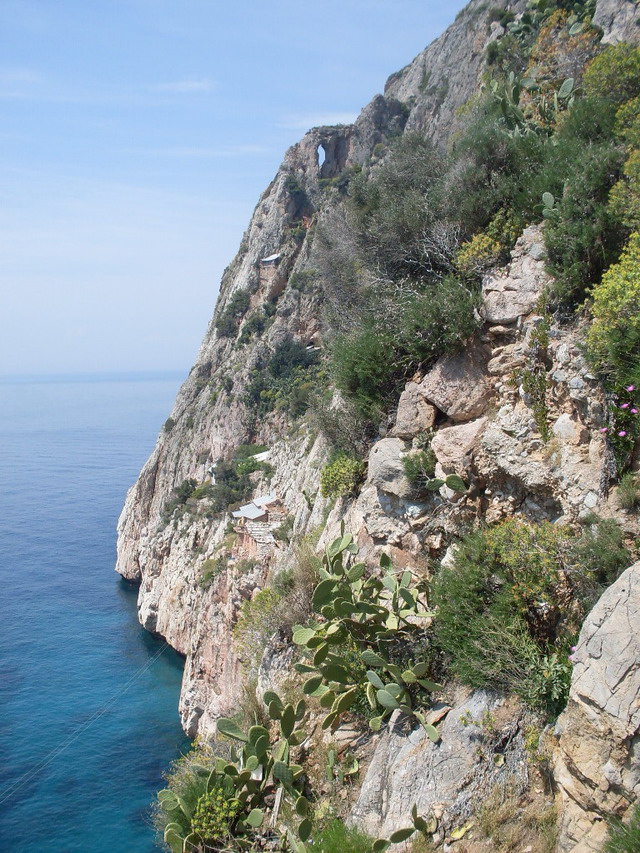
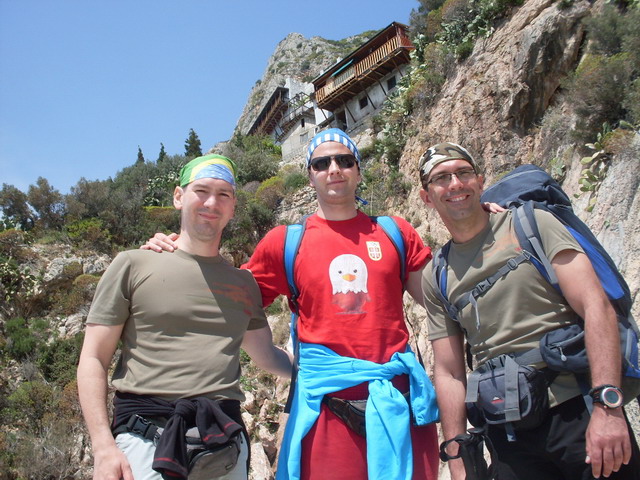
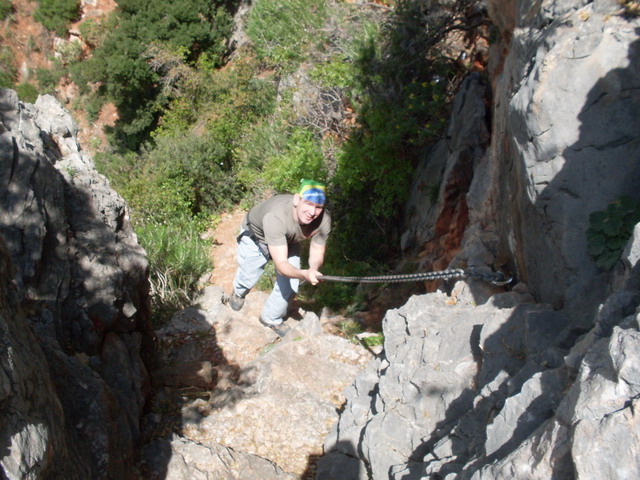

The ladder goes down on a steep rock. In the pictures climbing down looks really scary, but it is not. Chains are bolted to the rock, and there’s no chance of breaking off. Of course, caution is required when you go. But, once you climb down, it is much easier. 
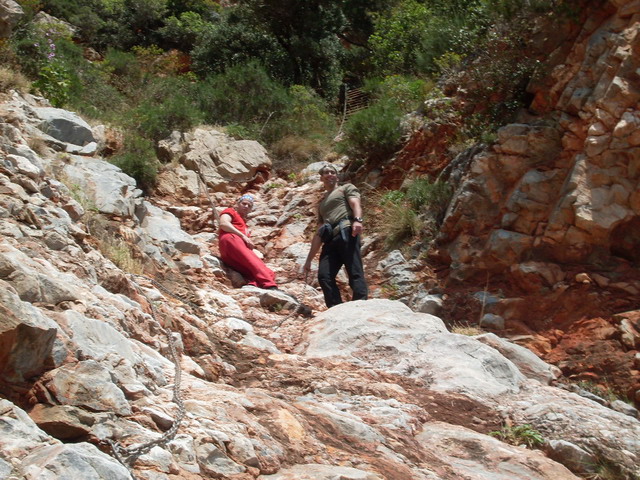

When you climb down, on the lesf side is, so-called, the red cave. It was a habitat of father Daniel, a Serb-zealot, who is now somewhere in Serbia. 
We followed the path that goes next to the rock. It is not that narrow as it seems on the photos. But still, IT IS NOT for heavy backpack! 
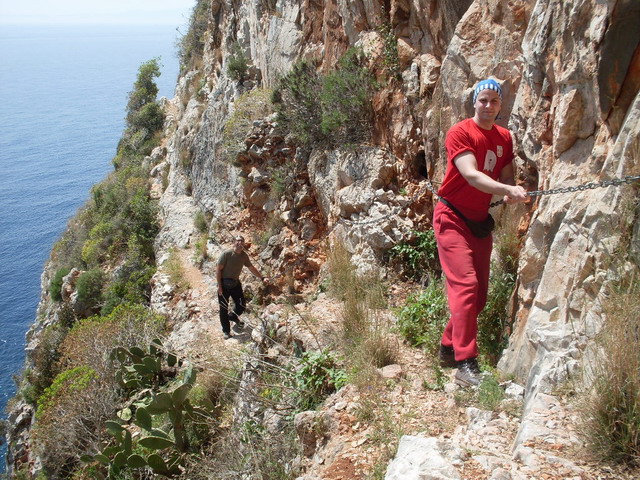
 After five minutes, we came to the first hermitages.
After five minutes, we came to the first hermitages. 

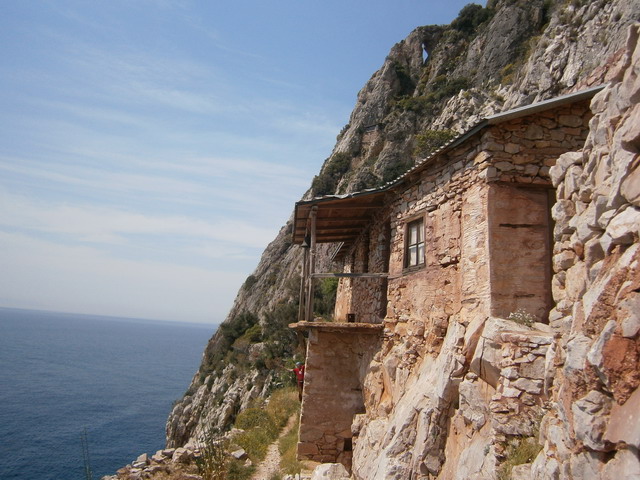







Winch (karoulia)


 We climbed to the church of St. George. Inside the church is the head of father Nikon, who was an adjutant of the Romanovs. The head of monk Innokenty (builder of St. Andrews skete) is also there. Unfortunately, we did not go into the church, no one was there to open.
We climbed to the church of St. George. Inside the church is the head of father Nikon, who was an adjutant of the Romanovs. The head of monk Innokenty (builder of St. Andrews skete) is also there. Unfortunately, we did not go into the church, no one was there to open.
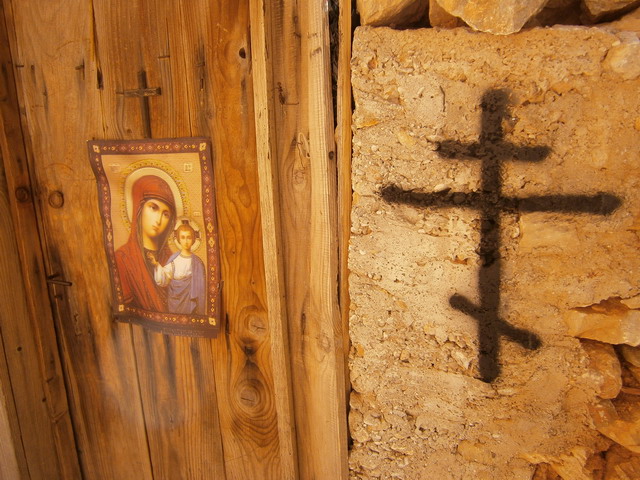
Church of St. George
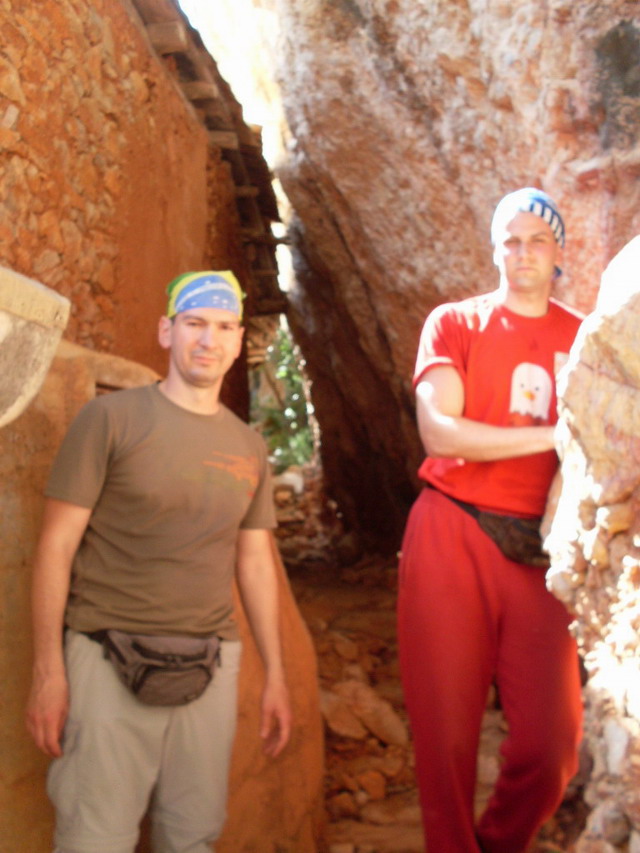 Through the passage between the church and the rocks, we continued to the ear of Karoulia, one of the symbols of this wilderness. Previously, we found ‘‘Karoulian way to the sea‘‘, a hole through which you can go down to the coast. Fascinating! However, don’t go down if you are overweight, these bars do not seem so sure.
Through the passage between the church and the rocks, we continued to the ear of Karoulia, one of the symbols of this wilderness. Previously, we found ‘‘Karoulian way to the sea‘‘, a hole through which you can go down to the coast. Fascinating! However, don’t go down if you are overweight, these bars do not seem so sure.
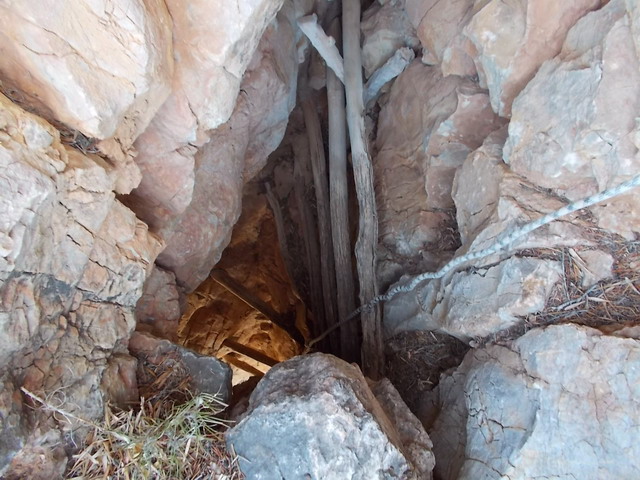
Karoulian way to the sea


Ear of Karoulia

 Ear of Karoulia is the endpoint of our tour. There is a lot of cells around this place, God’s providence led us to the cell of a young Estonian father Raphael. It is located across the ear, at highest point.
Ear of Karoulia is the endpoint of our tour. There is a lot of cells around this place, God’s providence led us to the cell of a young Estonian father Raphael. It is located across the ear, at highest point.

Cell of father Raphael
Like all residents of the desert, father Raphael welcomed us warmly and with a broad smile. He showed us a cell in a cave, whose tunnels leads 2 km through the hill to the skete of Micro Agia Anna! The left leg of this cave leads to the two small hermitages on the cliff. He told us that, a few years ago, German pilgrims went into the cave and never came out! When I asked him how they survive winter at Karoulia, Raphael told me that winter is not a problem, because the temperatures are from 12 to 15 ºC. Problem is at summer, because of unbearable heat. Father Raphael told us that 300 m above him father David lives. He is Serb. Great, finally someone with whom we can talk Serbian! Raphael came on one platform and shouted: “Father Daviiiid! ” Soon, on a high cliff, our father David showed up. Somehow, by shouting, we agreed to meet him on the main trail in an hour. But, first we went in a cell – cave. Indeed, there is a way through the cave that leads God knows where, the left leg is blocked by heavy barrel, so we could not reach the hermitages. In the tunnel we found a well, a cross from Jerusalem and bones with a yellow skull of a monk – saint. That cell is abandoned, its last inhabitant was some Russian monk. The cell can be recognized by this tank and a platform which is located on a tree. 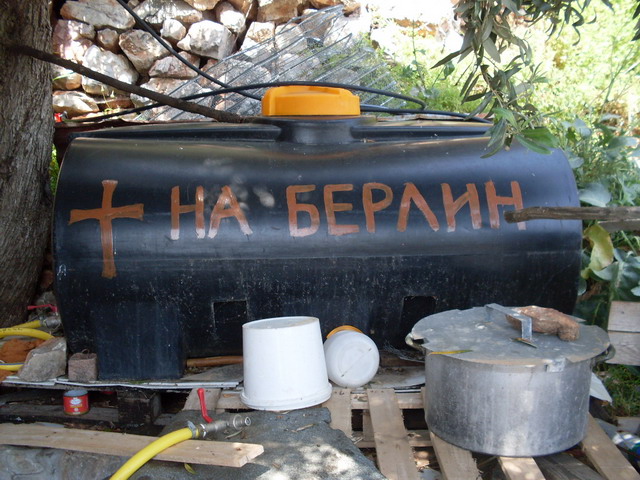



It is possible, by the chains, to climb above ear of Karoulia, but there is no more cells. I think you can climb all the way to the skete of Daneeley, but that’s a pretty strenuous adventure. 

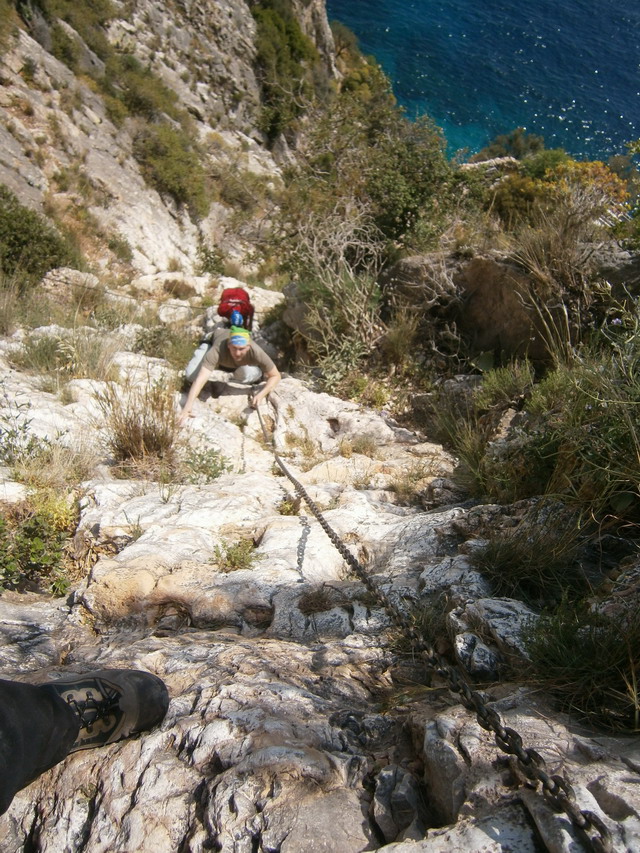


Above the ear of Karoulia
After fifteen minutes, we are at the starting point. We wonder how it took us such a short time to return. We needed about an hour and a half to the ear of Karoulia, but we explored the cells on our way to the ear. 
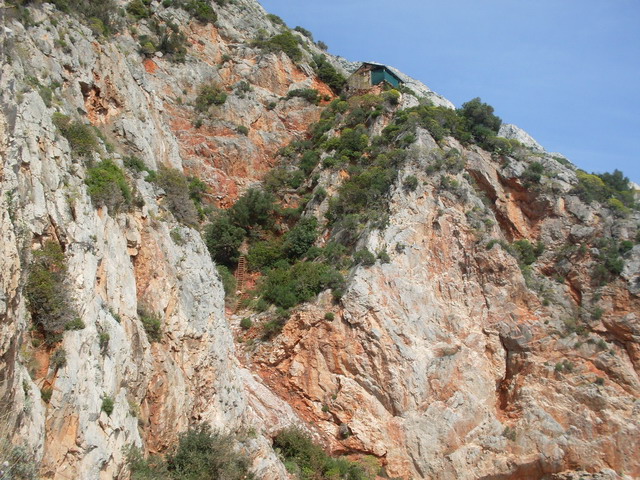

We returned to the stairs, took our backpacks and headed to a meeting with David. There’s no way we could find a path to his hermitage, it is good that David waited us on the road. Father David is also a zealot. He is in his forties, openhearted and happy as a little kid! It’s amazing how he was delighted, like he knows us his whole life! Immediately, he set the table with all the food he had, we hardly convinced him that we are not hungry. Previously, he showed us his “dining room”. Two stumps with a plank between them represents the table, and two more stumps next to the tabel “table” represents the chairs. David has a summer kitchen, a pile of ash covered with a grill for a barbecue! How little it takes for a man to be happy! His cell is actually a cave, combined with the lobby made of boards. Really, what more monk needs at this blessed place? We were talking about different topics, how is in the world and what is going wrong, I wanted to know something about temptations at Karoulia. David said that temptations are much higher here than in the monasteries, because in the monasteries, due to a strong prayers, only minor demons exists, and here, among the hermits, demons “princes” lives. Each cell has one, demon of immorality, pride, anger and similar. Although, he said, 50 years ago were much greater temptations. David talked about father Daniel, who is also Serbian. Once, while he was praying, father Daniel saw a monk – demon in black robe and with eyes that glowed a bright – red color. Daniel chased him but demon disappeared in the cave. At the end, we took a picture with David but, at his request, I will not publish this photo. 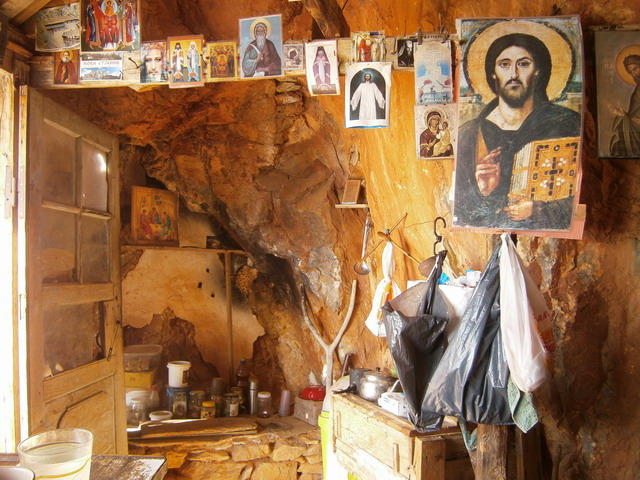



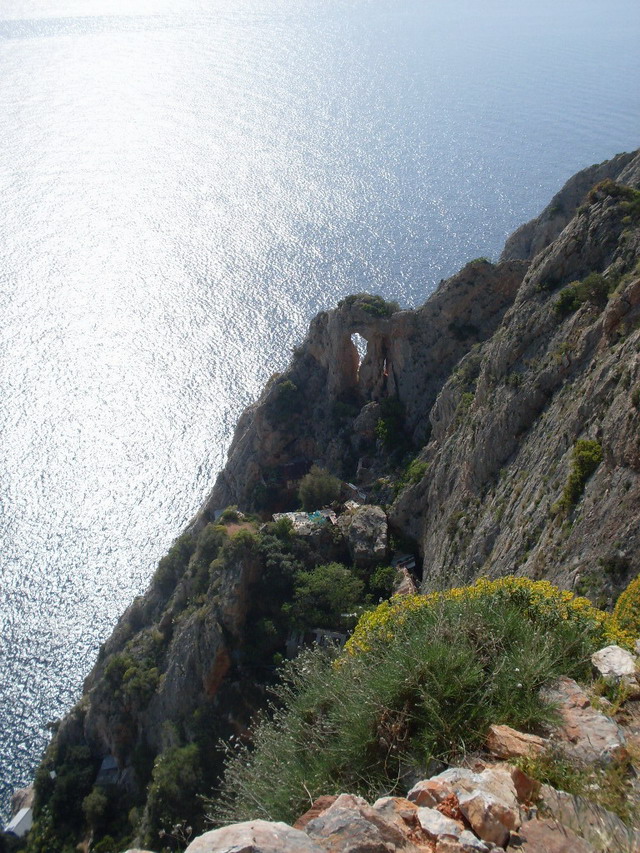
 We leave this strange place full of impressions and grace.
We leave this strange place full of impressions and grace.
We concluded that Karoulia is the most impressive place on Mount Athos, and we are looking forward to return again. We went further by the stairs and after twenty minutes we arrived at the skete of Daneeley. Monks from this skete are the best icon painters on Holy Mountain.

Daneeley
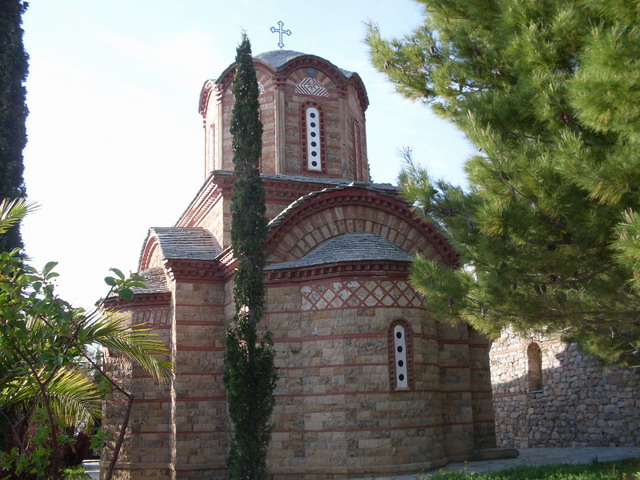 From Daneeley, left trail leads to the skete of St. Anne and Little St. Anne, the right path leads to Katounakia. Katounakia is, actually, the roof Karoulia and it is located 15 minutes from Daneeley. Katounakia is a collection of all cells located in this part of Athos. Before I continue with Katounakia, I would like to describe an event at Micro Agia Anna skete. Distance between Daneeley and Micro Agia Anna is an hour of walk. We spent the night there and in the morning decided to try to find one of the most respected spiritual father at Holy Mountain, elder Papa Giannis. After deaths of elder Paisios and elder Porphyrios, Greeks were looking for someone similar to them, and they found him in Papa Giannis. One guest of the skete took us and two yonger Greeks to the elders cell. Soon, an old man with a smile on his face appeared. It was the elder Papa Giannis. Through the window of the gate he asked us where we were and why we came, just to see him or to ask him a question? We said we are Serbs and then he said a few words in Serbian. He asked us some questions that convinced us that he has a gift of clairvoyancy. He took us to the yard, and continued with the story about his fought in Macedonia against the Germans. He remembers Tito and Yugoslavia although he is a monk for 70 years! He is 86 years old, but his brain is like a sharp razor, which is not surprising for someone whose mind continually dwells in prayer. Then he gave us some tips, what we should do in our lives and how to save our souls. Those few words were enough to make us believe in his clairvoyancy and great boon he posses. Calmed and with his blessing we continued our travel. Now I am going back to Katounakia.
From Daneeley, left trail leads to the skete of St. Anne and Little St. Anne, the right path leads to Katounakia. Katounakia is, actually, the roof Karoulia and it is located 15 minutes from Daneeley. Katounakia is a collection of all cells located in this part of Athos. Before I continue with Katounakia, I would like to describe an event at Micro Agia Anna skete. Distance between Daneeley and Micro Agia Anna is an hour of walk. We spent the night there and in the morning decided to try to find one of the most respected spiritual father at Holy Mountain, elder Papa Giannis. After deaths of elder Paisios and elder Porphyrios, Greeks were looking for someone similar to them, and they found him in Papa Giannis. One guest of the skete took us and two yonger Greeks to the elders cell. Soon, an old man with a smile on his face appeared. It was the elder Papa Giannis. Through the window of the gate he asked us where we were and why we came, just to see him or to ask him a question? We said we are Serbs and then he said a few words in Serbian. He asked us some questions that convinced us that he has a gift of clairvoyancy. He took us to the yard, and continued with the story about his fought in Macedonia against the Germans. He remembers Tito and Yugoslavia although he is a monk for 70 years! He is 86 years old, but his brain is like a sharp razor, which is not surprising for someone whose mind continually dwells in prayer. Then he gave us some tips, what we should do in our lives and how to save our souls. Those few words were enough to make us believe in his clairvoyancy and great boon he posses. Calmed and with his blessing we continued our travel. Now I am going back to Katounakia.
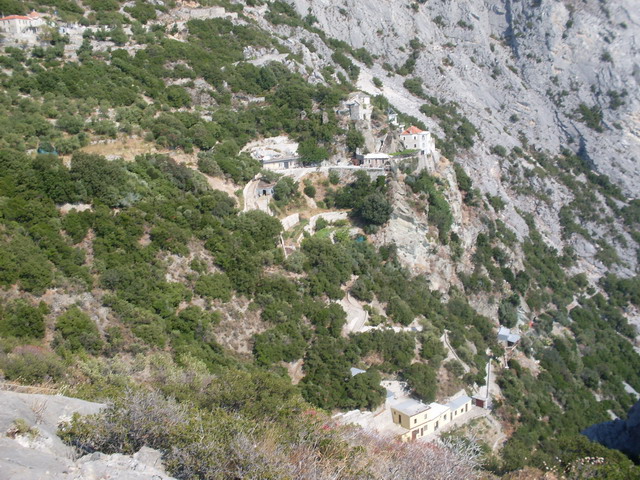
Katounakia
 Going south from Katounakia, first you will reach Kerasia, then Kavsokalyvia and, at the end, the cell of St. Nilus the Myrrgusher. From St. Nilus, path leads to Romanian skete of Prodromos and then to the Great Lavra, which is on the east coast. Path from Katounakia to Kavsokalyva is quite challenging, due to the constant and very steep climb, so I highly recommend sailing by boat. If you prefer hiking, then you will climb from Katounakia through the ravine, all the way to the intersection called Stavros (Cross). There are signposts to Kerasia and Kavsokalyvia. You need to overcome a height difference of at least 700 m, which can be very hard, especially in August. On your way, you will pass the skete of St. Basil.
Going south from Katounakia, first you will reach Kerasia, then Kavsokalyvia and, at the end, the cell of St. Nilus the Myrrgusher. From St. Nilus, path leads to Romanian skete of Prodromos and then to the Great Lavra, which is on the east coast. Path from Katounakia to Kavsokalyva is quite challenging, due to the constant and very steep climb, so I highly recommend sailing by boat. If you prefer hiking, then you will climb from Katounakia through the ravine, all the way to the intersection called Stavros (Cross). There are signposts to Kerasia and Kavsokalyvia. You need to overcome a height difference of at least 700 m, which can be very hard, especially in August. On your way, you will pass the skete of St. Basil.
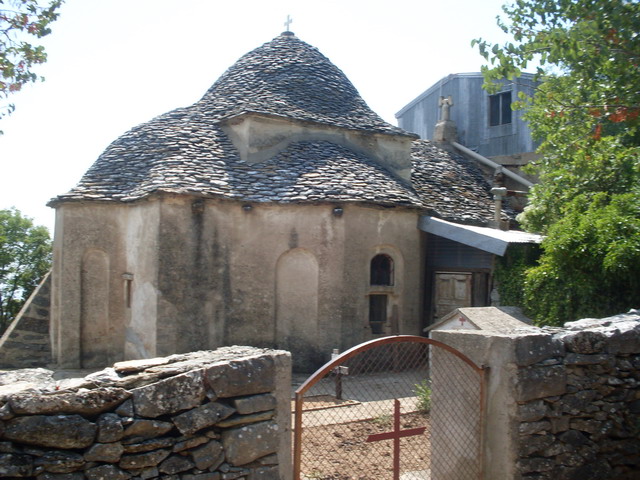
Skete of St. Basil
Stavros is a crossroad of roads where one goes to the top of Mount Athos, second path leads to Micro Agia Anna and the third to Great Lavra. This is the last place, if you climb Athos, where you can supply with water. As I recall, from the cell of St. Nilus to Micro Again Anna (via Kavsokalyvia, Kerasia, St. Basil and Katounakia) should be a minimum 4 hours of walking. From Stavros path slides down, the first stop is the skete of Kerasia. The main church is dedicated to St. George. This skete was build by Russians.

Kerasia
 Next stop is Kavsokalyvia. Kavsokalyvia means “burned huts.” It was named after St. Maximus of Kavsokalyvia, great spiritual leader and teacher of Jesus mind prayer. He had a habit of frequently changing habitats. Before the move, he burned every hermitage where he lived.
Next stop is Kavsokalyvia. Kavsokalyvia means “burned huts.” It was named after St. Maximus of Kavsokalyvia, great spiritual leader and teacher of Jesus mind prayer. He had a habit of frequently changing habitats. Before the move, he burned every hermitage where he lived. 

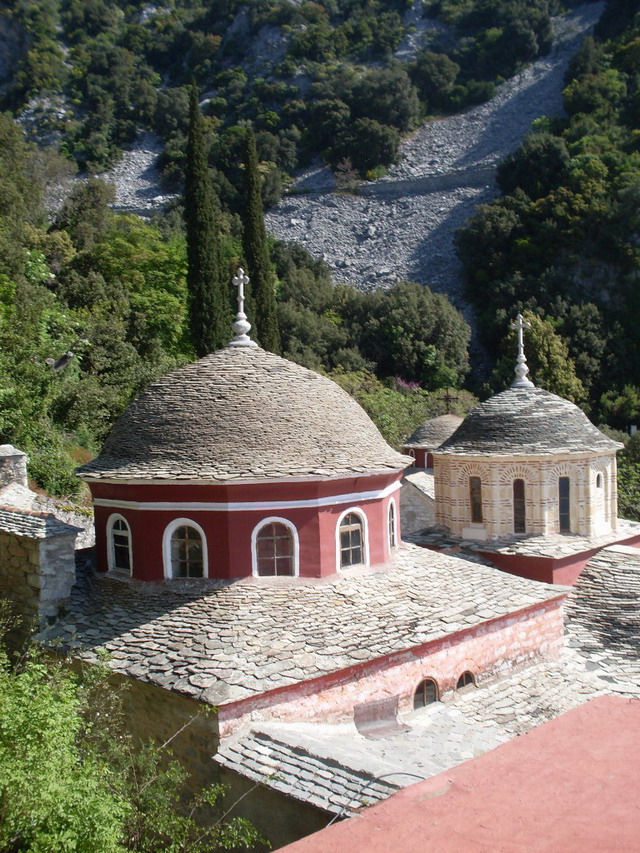




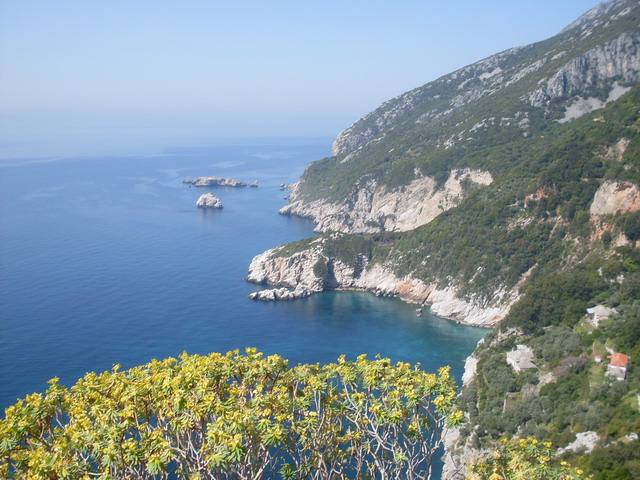

Kavsokalyvia
One hour of walk from Kavsokalyvia is a cell of St. Nilus the Myrrgusher.

Cell of St. Nilus

 Part of the road that goes from the cell of St. Nilus to the entrance of the forest on the way to Prodromos skete, is one of the most beautiful on the Holy Mountain.
Part of the road that goes from the cell of St. Nilus to the entrance of the forest on the way to Prodromos skete, is one of the most beautiful on the Holy Mountain.
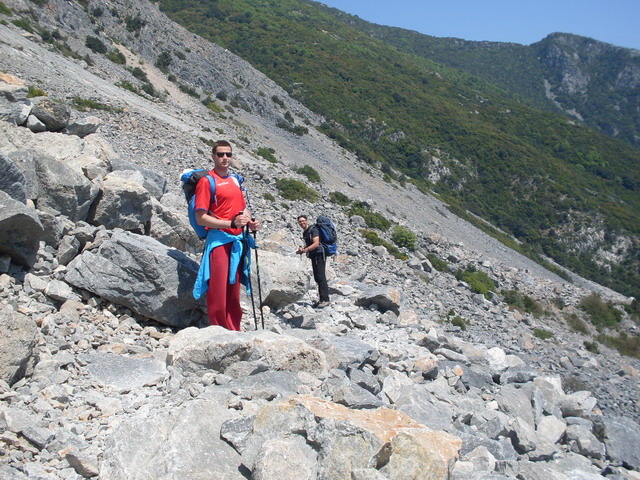

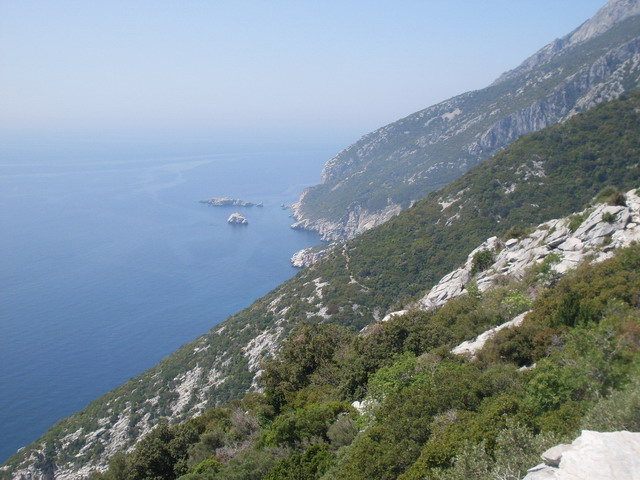 Distance between St. Nilus and Prodromos is about two and a half hour of walk.
Distance between St. Nilus and Prodromos is about two and a half hour of walk. 
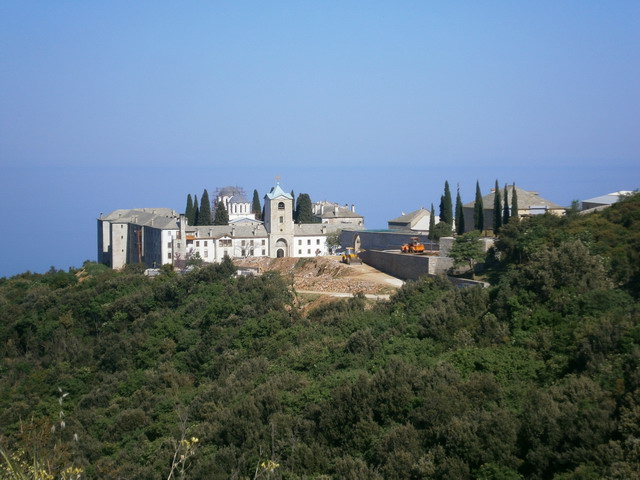
Prodromos
Skete of Prodromos (or skete of John the Baptist) is inhabited by Romanians. It is strange that the Romanians do not have their monastery on Mount Athos, considering that their rulers helped the construction and renovation of many monasteries of Mount Athos during centuries. Prodromos owns an icon of Holy Mother called Prodromisa, one of two icons on Mount Athos that was not made by hands. The second icon is the icon of St. George and it is located in Zograf monastery. Prodromos is located very close to the most southern point of Athos, near Cape Akratos. Behind Prodromos, on the south, is a small fortress. Actually, it is a cell of St. Minas. Around it are numerous cells, one of them is the cell of the Shroud of the Holy Mother. We did not miss the opportunity to get down to the cave of St. Athanasios the Athonite, founder of the Great Lavra and Athonite monasticism.
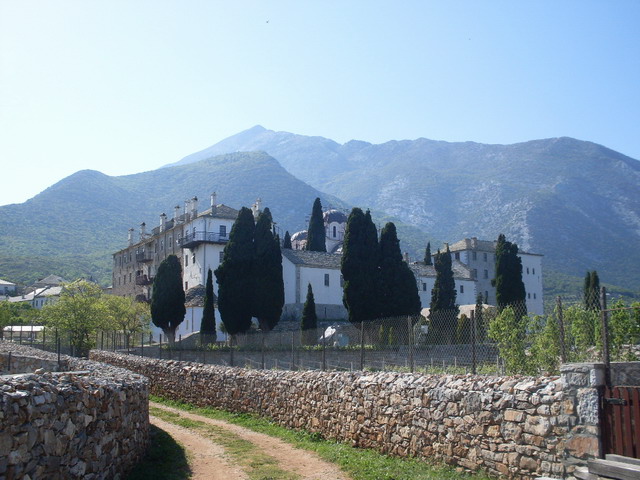



St. Athanasius cave
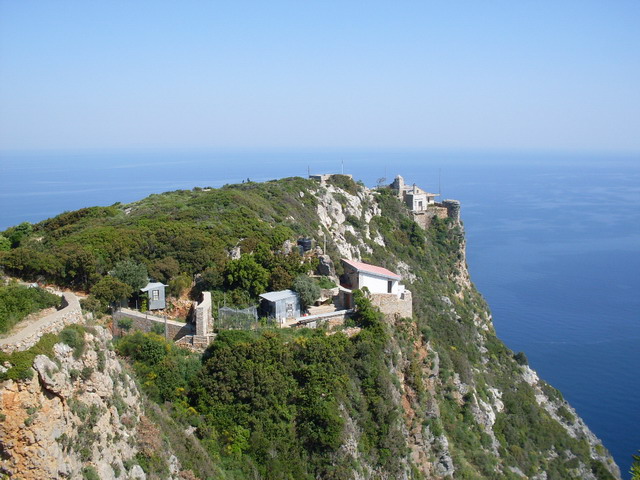

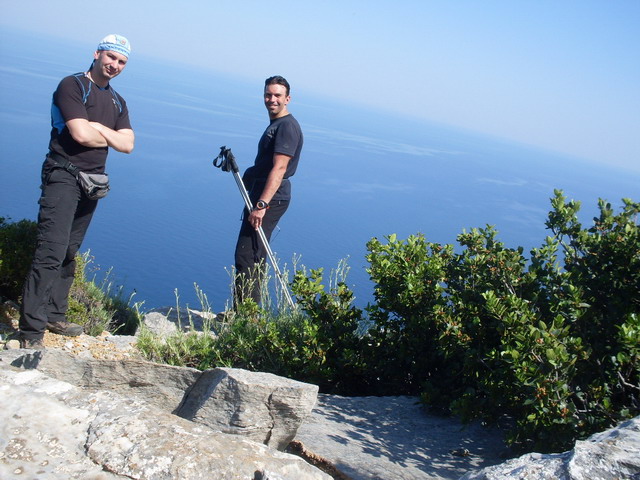

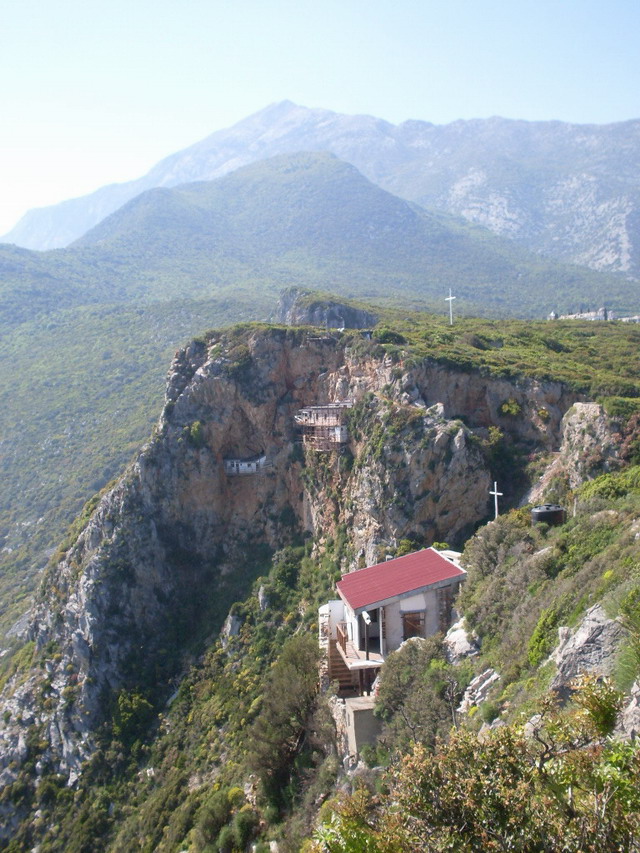
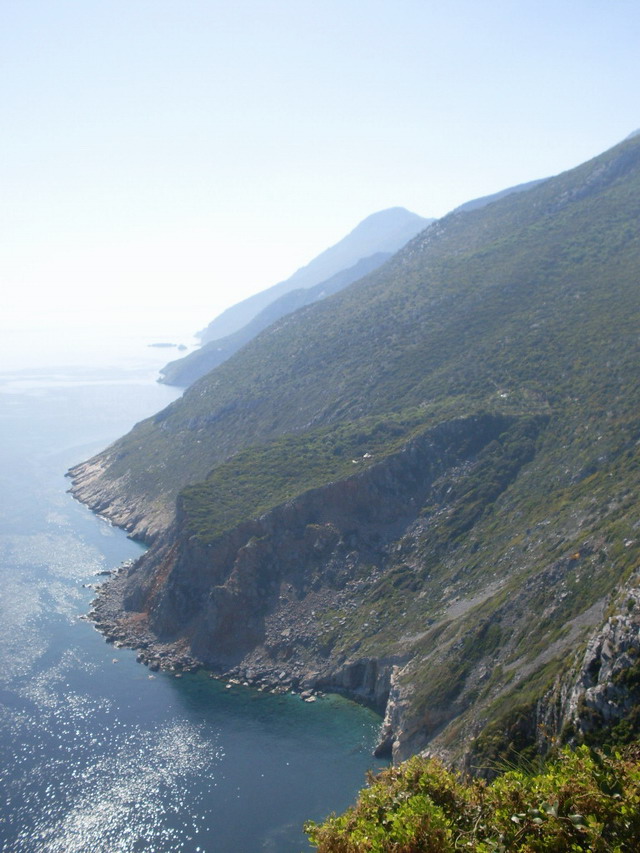


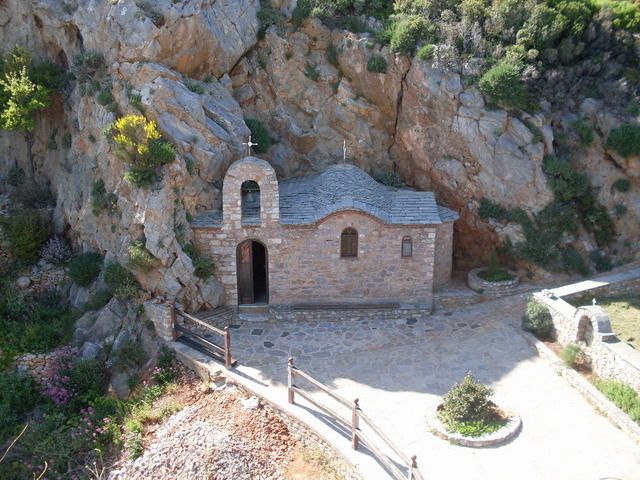
Cell of The Shroud of the Holy Mother
We overnight at Great Lavra and left by the van in the morning. Van left us at the turning to Lakku skete. Our final destination is monastery of Philotheu. We also wanted to visit Lakku skete and cell Provata. At the beginning, the trail passes beside Amalfi tower, which is the remain of a Benedictin monastery. It was founded in 980 year, by the monks from the Italian town of Amalfi. Monastery was destroyed in 13th century, probably by the Crusaders.

Great Lavra

Amalfi tower

 Path leads beside the Amalfi tower and then goes down into the creek. Distance between tower and Lakku skete is about two hours. Along the way, there are road signs that points you to the Lakku skete.
Path leads beside the Amalfi tower and then goes down into the creek. Distance between tower and Lakku skete is about two hours. Along the way, there are road signs that points you to the Lakku skete.

Lakku skete
Skete is inhabited by Romanians. We were wondering if we will be able to find the path to Provata and monastery Karakalou, because there are many roads from here. A Romanian monk, whose name I have forgotten, immediately hit us with a joke: “You have a knife, flashlight, map? So what if you get lost, it’s Athos, you will be lost in paradise!” Well said and totally true! God’s providence wanted from us to meet the three pilgrims, father, son and grandson. They took us with them to the cell of father Stephen. Father Stephen should drive them to Karyes and there will be a place for us in the van. Unfortunately, Stephen left early in the morning to Karyes, so we are again on our own. However, the young hieromonk, father Paisios, explained us how to find the right track. He told us just to follow the main, dusty road and signs to Provata. And so it was. We were walking by that dull and dusty road. We came to a crossroad with signposts for Philotheu, Provata, St. Paul and other monasteries. I think it took us over 2 hours to Provata. Provata is a small, but very beautiful cell, populated with Moldavian monks. They were very happy when they saw us. I guess that it is because only a few people come to them, they are not on the main road. When they heard from where we are walking, they immediately set the table. I can not remember when was the last time I ate such a delicious cake!

Provata
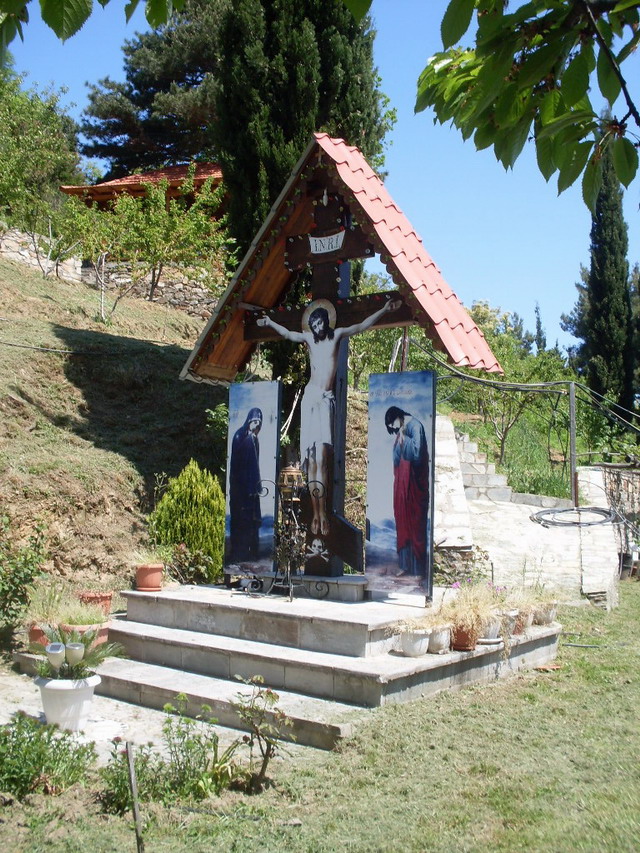
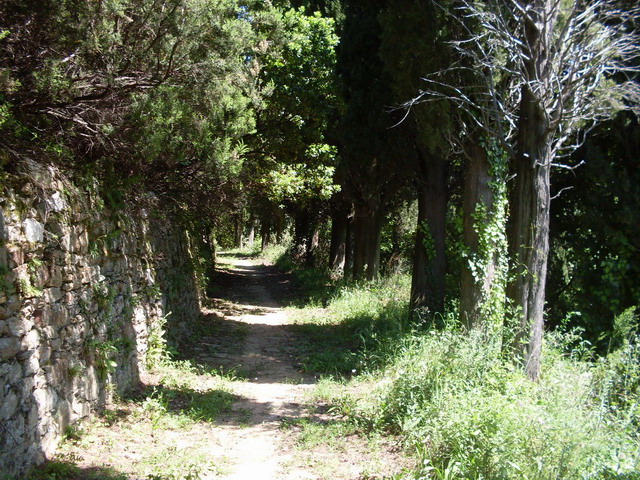 We are moving toward Karakalou and Philotheu. We’re walking by the main road and follow the signs. At one junction there is no signs, but the feeling and the map tells us to go to the right, slightly uphill. If you go by this way, choose right path at this junction. About an hour and a half and we arrived at the monastery Karakalou. Another 45 minutes and we arrived at Philotheu.
We are moving toward Karakalou and Philotheu. We’re walking by the main road and follow the signs. At one junction there is no signs, but the feeling and the map tells us to go to the right, slightly uphill. If you go by this way, choose right path at this junction. About an hour and a half and we arrived at the monastery Karakalou. Another 45 minutes and we arrived at Philotheu.

Karakalou

Philotheou
Tomorrow, we are hiking to Iviron. We hitched a jeep with two Romanian monks, it turned out that the driver was monk Stephen from Lakku skete, the same one we were looking for the day before! We’re talking about ecumenism and evil in the world, monks are asking for Serbian father Justin and Bishop Nicholas. Those Serbian saints are really respected on Mount Athos, this is not the first time that monks are showing interests in them.

Iviron
We visited Iviron, venerated Portaitisa and continued to the skete of St. Andrew in Karyes. There we meet our old friend, father Nikolaos. Nikolaos is a guestmaster and he is very pleased that we came again. “You know, every night I pray for the three of you,” he said. This really touched me, is it possible that one monk prays everyday for me, miserable and unworthy? We were talking after dinner, Nikolaos noted with tears that, in Serbia, he has more dead than alive friends. Father Nikolaos spent a lot of time in Arandjelovac at his time, hence his great love and respect for Serbs. I’ll never forget his words when we first met: “No, you are not Serbs, you are Orthodox Serbs! Are you aware what that means?” We talked with him about our meeting with Papa Giannis, Nikolaos said that because of Papa Giannis (and few other elders) prayers Mount Athos still exists. ‘‘But, hard times comes, to Greeks and to Serbs and for us here,” finished Nikolaos.
In the gorgeous church of St. Andrew, I noticed a large icon of Serbian elder Justin Popovic. Another proof how Athos monks respect and love Serbs.

Skete of St. Andrew

Tomorrow we went to Pateritsa. Pateritsa is Chilandar cell where the episcopal staff of St. Sava was kept. St. Sava the Serb brought it from Jerusalem. St. Sava visited Jerusalem in 1229. According to tradition, St. Savvas the Sanctified, before his death (sixth century), has left a legacy to his brethren to put his episcopal staff (pateritsa) near his grave. He predicted that one day a young monk of noble birth will come from the west. Monks should give that monk the episcopal rod and the icon of Mother of God – ‘‘Milk Giver‘‘. While he was worshiping the grave of St. Savvas, rod fell to the ground. That was the sign that the prophecy is true. Also, St. John Damascene left a legacy to give the icon of Holy Mother of ‘‘Three Hands‘‘ to a “monk of noble birth”. And so it was, everything happened as in the prophecy. Today, the rod is in the Hermitage of Saint Sava in Karyes.

Pateritsa
Beyond the walls of the Athonite Academy (located in skete of St. Andrew) is a path that leads to another Chilandar cell, Bourazeri. Distance from skete to Bourazeri is less than half an hour. After Bourazeri we went to an hour away skete of St. Elijah. This skete was built by the Russians, now belongs to the monastery of Pantokrator. The church is a typical Russian style, large and luxurious. Once this skete had more monks than skete of St. Andrew. From this skete is a beautiful view at the monastery of Pantokrator.
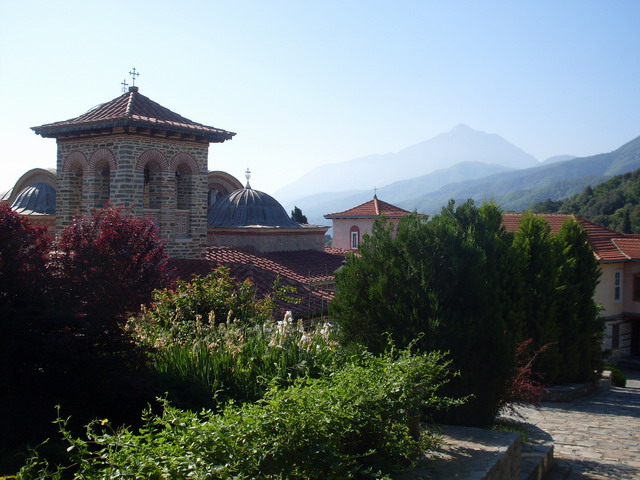
Bourazeri


Skete of St. Elijah
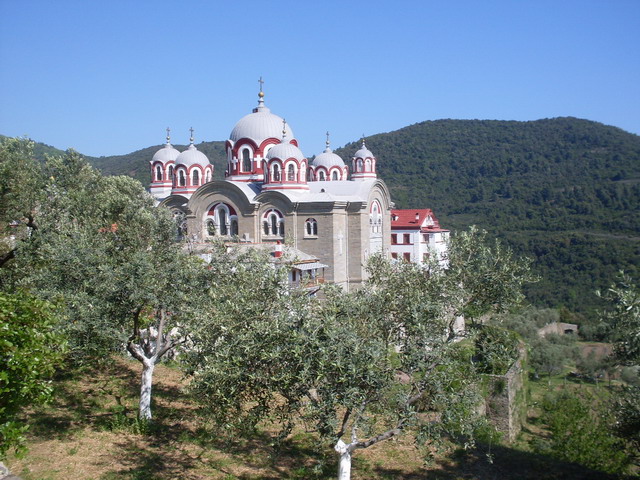

Pantokrator
From skete of St. Elijah, we moved to another settlement that most pilgrims avoids, skete of Bogoroditsa. Once there was a splendid monastery Xilurgu. The remains of the walls testify to its former glory. Skete of Bogoroditsa or Xilurgu – it is the same. A monk from the Monastery of St. Elijah explained to us how to get to Xilurgu, but we made the wrong turn at the start. We even had a full explanation from this website: http://www.athosfriends.org/footpaths/ProfitisIlias_Bogoroditsa/ .
When you get out of the gate, after 10 meters, turn right into the forest. You will see a small orange patch on a tree, representing the marking. You’ll notice a yellow sign “Monopati.” From here, you need about 45 minutes – an hour to Xilurgu. Read the instruction from the website www.athosfriends.org, there are a few turns that can confuse you. We went right to the main road and after an hour we realized that something is wrong.

Path to Xilurgu
We went back and find the right path. Soon we arrived at Xilurgu. The main church is dedicated to the Assumption of the Holy Mother, and within the skete there are two chapels dedicated to St. John of Rila and Cyril and Methodius. Once Bulgarian monks lived here, today skete belongs to Russians and to the monastery of St. Panteleimon. Once again, brothers Russians greeted us with enthusiasm. Head of the skete, father Simon, is an imposing figure of a true Orthodox! He is a real spiritual giant! We had a long conversation at the table with him and Seraphim, a deacon who is studying in Thessaloniki. Of all the monks I met on Mount Athos, the Russians are something special. They are quite different than the other monks, very strong and firm in faith. And they truly love Serbs!

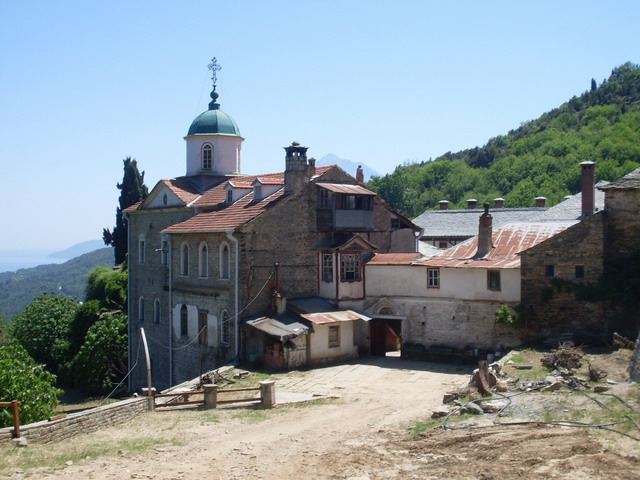
Xilurgu
Simon directs us to the main road to Vatopedi. Road signs to Vatopedi are visible and clear. An hour and a half and we are at Vatopedi. Tomorrow we get the blessing and moving toward Esphigmenou.

Vatopedi
Esphigmenou, a zealot monastery, despite enormous pressure, still resists! Neither the use of physical force can not disrupt the Orthodox zealots!

That year was a fire in the hills around Chilandar and approached to the monastery at a mile and a half! Father Simeon, Serbian, told us how it all looked. “I look and saw the fire jumped from one hill to another, a miracle of God! We were wondering what to do, we packed our bags ready to flee, if the fire goes into our direction. One night, I thought how wonderful it would be to sleep outside my cell, because it is very beautiful and pleasant night, when suddenly, a miracle happened! It was such a storm out of the blue sky! A lot of rain fell! And before that, almost 3 months was without a drop! Mother of God took a pity on us!”
Chilandar organized a procession around the monastery, carrying a copy of the Three Hands icon, part of the Holy Cross and the icon of the Mother of God “Comfort of Sorrow”. Holy mother granted their prayers, the monastery was saved!
I really like to talk with Simeon every time I stop at Esphigmenou. Now we talk about the various prophecies and the final clash between Catholics, Muslims and Orthodox, and how we are very close to the end of time. Signs are showing, flags are bleeding, army is ready. Ecumenism and heresy took hold in the Orthodox Church, concluded Simeon.
Next to the cemetery is a path that leads to the cave where St. Anthony, the father of Russian monasticism and founder of the Kiev – Pechersk Lavra, lived. From this place is a beautiful view at Esphigmenou.

Esphigmenou
Journey ends, as always, in Chilandar. There are not many guests, because of fire. The monks do not talk much, but they say it is good, thank God that fire stopped.
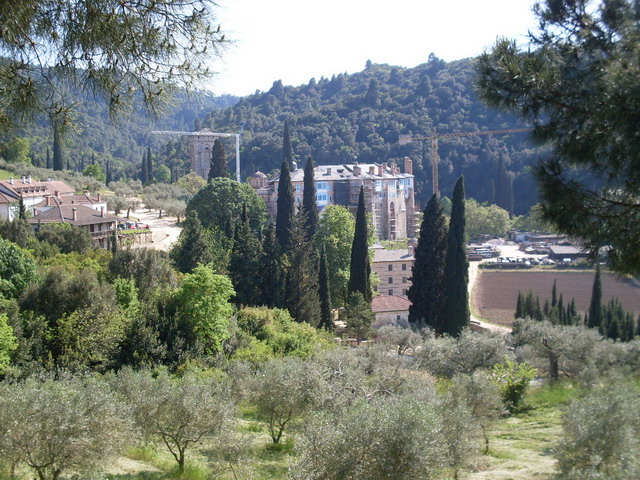
Chilandar
I would also like to mention our converstion with father George in Zograf, our old friend. This time, father George spoked lovingly about the Serbo-Bulgarian relations, how we need to love and respect each other and that is a tragedy that we, though orthodox, fought so often. Zographic monks, during the NATO bombing of Serbia, sent a letter to the Bulgarian Parliament with appeal to condemn the aggression and stop cooperation with NATO, but it did not work. In every nation you can find a good and honest people.

Zograf
At the end, I would like, with unconcealed delight, to conclude that this fifth visit to the Holy Mountain was the most memorable. Away from the world and alone with your thoughts, it is not difficult to examine your own life with spiritual eyes and direction where you go. Here, everything is simple. I know exactly what to do next, which way to go, and what I am doing wrong. Unfortunately, the speed of the modern life and the madness of the world, forces me not to put an end to my previous mistakes, but only a comma.
At Athos, every day is the same for over a thousand years. The order is – wake up, liturgy, breakfast, obedience, prayer. On the Holy Mountain time stands still. Here you will realize how little it takes to be happy. Spiritual eyes opens wide at this place. The grace of this place makes you a better person, learning how to forgive and love all people. You’ll realize true values, reject the material and accept the spiritual way of life. Life can be very simple if you have strong faith. I pray to God to give me the strength and faith to sin no more, to be a better person and to learn how to save myself in these last times!


Simonopetra

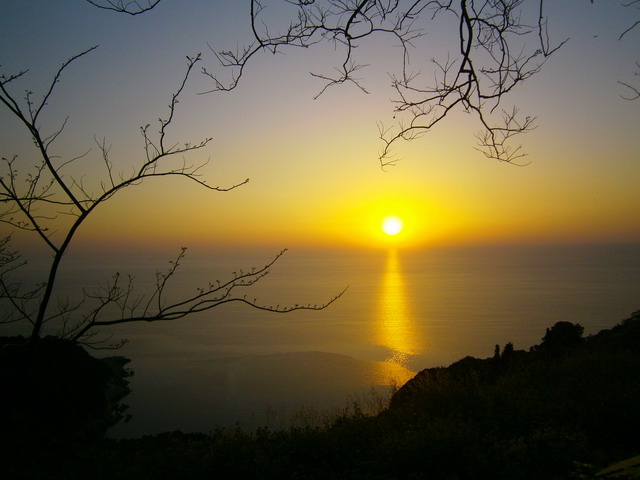
May 2013.
3 Responses to “MOUNT ATHOS – Karoulia”
Leave a Reply
You must be logged in to post a comment.


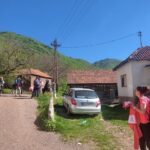

 Srbija na dlanu
Srbija na dlanu SVETOGORSKE TURE
SVETOGORSKE TURE Moja planeta
Moja planeta Vila Ćetković
Vila Ćetković Jooble
Jooble Outdoor Srbija
Outdoor Srbija
Absolutely fabulous report, especially the part about Karoulia ! Can we expect more another year ?
good pictures and you are brave good klimming and the blessing of god
What a beautiful foto-report of your trip on the Holy Mountain. I am looking forward to your next Athos-trip reportage.